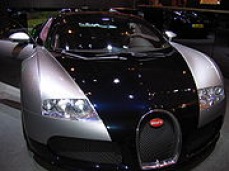Bugatti Veyron

The Bugatti Veyron 16.4 is a mid-engine sports car produced by Volkswagen Group subsidiary Bugatti Automobiles SAS introduced in 2005. It is currently the fastest accelerating and decelerating production car in the world. It is currently also the most expensive production car available at a price of 1.1 million Euro. It is able to achieve the second highest top speed for a production car, behind the SSC Ultimate Aero TT.
Powered by a 736-kilowatt (1,001 PS/987 hp) W16 engine, it is able to achieve an average top speed of 408.47 km/h (253.81 mph). The car reached full production in September 2005, and is handcrafted in a factory Volkswagen built near the former Bugatti headquarters in Château St Jean in Molsheim (Alsace, France). It is named after French racing driver Pierre Veyron, who won the 24 hours of Le Mans in 1939 while racing for the original Bugatti firm. Two examples of the Veyron are known to have been wrecked since production began.
Development of this vehicle began with the 1999 EB 18/4 "Veyron" concept car which itself had a chassis based on that of the Bugatti 18/3 Chiron concept car. Introduced at the Tokyo Motor Show, it was similar in design and appearance to the final Veyron production car. One major difference was the EB 18/4's use of a W18 engine with three banks of six cylinders. The Veyron's head designer was Hartmut Warkuss with exterior designed by Jozef Kabaň of Volkswagen rather than Giorgetto Giugiaro of ItalDesign who had handled the three prior Bugatti concepts too.
Volkswagen chairman Ferdinand Piëch announced the production Veyron at the 2000 Geneva Motor Show. It was promised to be the fastest, most powerful, and most expensive car in history. Instead of the W18, the production model would use a VR6/WR8-style W16 engine. First seen in the 1999 Bentley Hunaudieres concept car, the W16 would get four turbochargers, producing a quoted (metric) 1001 horsepower (see engine section for details on the power output). Top speed was promised at 407 km/h (253 mph), and pricing was announced at €1 million.
Development continued throughout 2001 and the EB 16/4 Veyron was promoted to "advanced concept" status. In late 2001, Bugatti announced that the car, officially called the "Bugatti Veyron 16.4", would go into production in 2003. The car, however, experienced significant problems during development. Achieving the required high-speed stability was difficult - one prototype was destroyed in a crash and another spun out during a public demonstration at the Monterey Historics event in Mazda Raceway at Laguna Seca. Production of the Veyron was delayed pending resolution of these and other issues.
A silver and black pre-production Veyron on display at the 2004 Paris Motor Show. Piëch retired that year as chairman of the Volkswagen Group and was replaced by Bernd Pischetsrieder. The new chairman promptly sent the Veyron back to the drawing board for major revisions. Neumann was replaced as Bugatti president by Thomas Bscher in December 2003, and substantial modifications were made to the Veyron under the guidance of former VW engineer, Bugatti Engineering head Wolfgang Schreiber.
Each Veyron is being sold for €1,100,000 (net price without taxes); prices vary by exchange rates and local taxes (like value added taxes). Prices for the UK or the US are over £800,000, or around $1,600,000.
Information from http://en.wikipedia.org/wiki/Bugatti_Veyron
